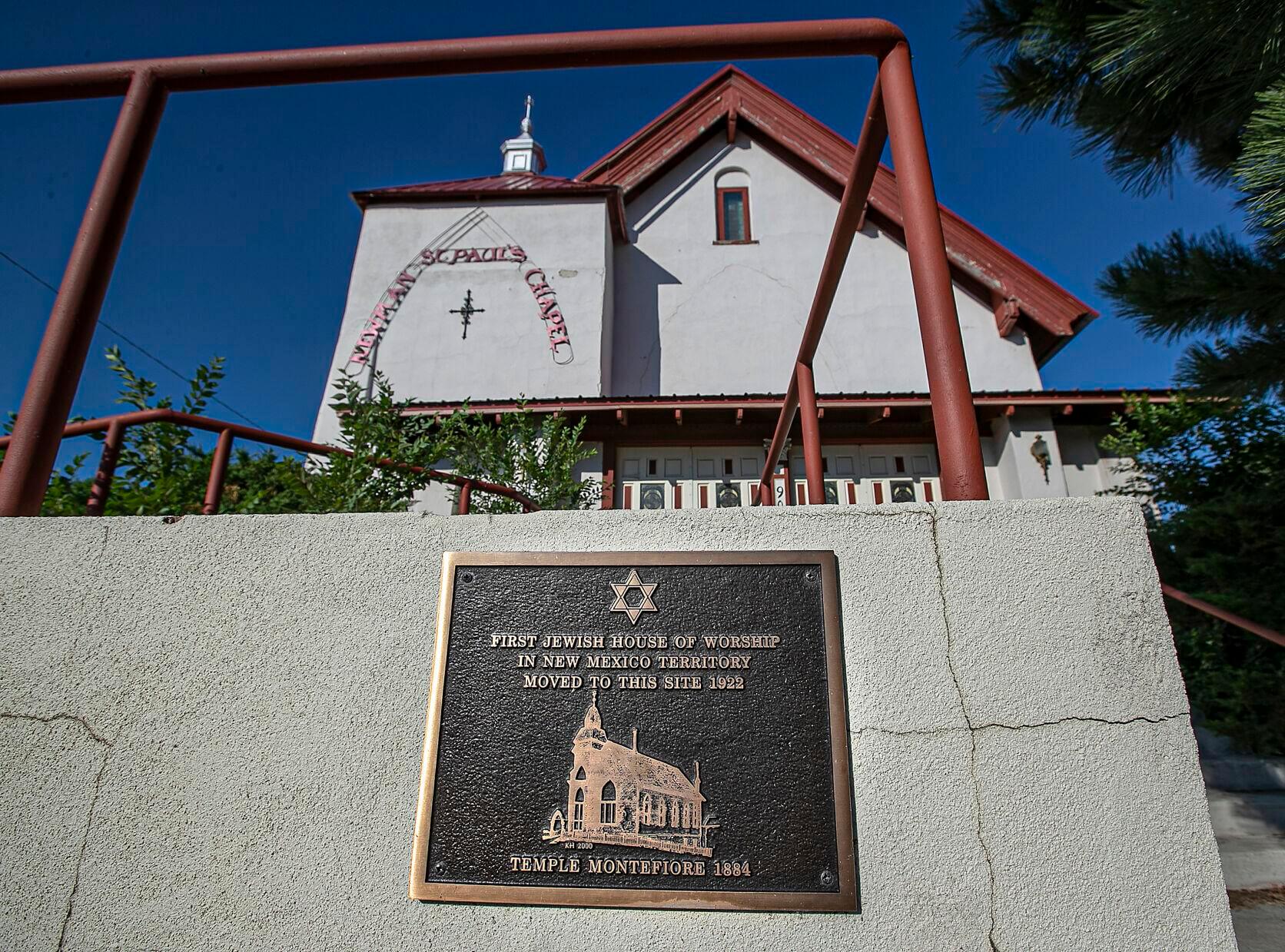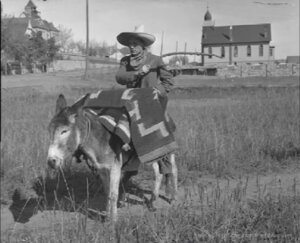They were forced to sell their beloved synagogue. 7 decades later, they finally have a chance to buy it back
The Montefiore Synagogue in New Mexico may be on the brink of being returned to the city’s small but thriving Jewish community.

Members of the Jewish community in Las Vegas, New Mexico, are trying to purchase Temple Montefiore, the oldest synagogue in the state, from the Archdiocese of Santa Fe. Photo by Jim Weber/The New Mexican
The Las Vegas, New Mexico, Jewish community is determined to buy back its synagogue.
It’s an opportunity few saw coming. The Santa Fe Archdiocese has owned the Montefiore Synagogue for some seven decades, and consistently refused to sell it back to the local Jewish community, despite repeated pleas.
But a $121.5 million settlement related to a Chapter 11 lawsuit about sexual abuse in the New Mexico church has pushed the archdiocese into bankruptcy — and forced a sale of the historic building, which Jewish leaders in the city of 13,055 have long aspired to make a new center of Las Vegas Jewish life.

Sure, the community has to drum up the funds to purchase the building. But “it will be bought by us,” said Zelda McCrossen, treasurer for the Las Vegas Jewish Community. “That’s a given.”
A GoFundMe page to help the community purchase the Montefiore Synagogue — which, per the archdiocese’s bankruptcy agreement, the archdiocese must sell within 30 days of signing — had raised more than $78,000 as of Wednesday afternoon. According to court documents, the Las Vegas Jewish Community and Archdiocese of Santa Fe entered a deal for the community to buy the synagogue and an adjacent house for an undisclosed amount on Aug. 23.
Since the Las Vegas Jewish Community does not have sufficient funds to meet that price on hand, they are crowdfunding to cover the costs.
A history, and a rebirth
The Montefiore Synagogue dates to 1886, a time when a large Jewish community had settled in Las Vegas and nearby Santa Fe. A train station was added to Las Vegas in 1899, making it more accessible.
However, by the 1950s, the Jewish community had dwindled, and could no longer afford to maintain the synagogue. The archdiocese purchased the property, and transformed it into a private facility for students at the nearby public Highlands University for students to learn about Catholicism.
The Jewish community of Las Vegas, which has been growing in the past decade, has, McCrossen said, made multiple offers to buy back the building in the past few years.
Tom Macken, a representative of the Santa Fe Archdiocese, said the church would be “delighted” if the synagogue returned to the Jewish community as planned.
The Las Vegas Jewish community today, McCrossen said, is a “mixed community” without any official denomination. “We do have a lot of converso and crypto Jews in northern New Mexico,” she said. But, she said, “we’re from all over.”
In recent years, the community has hosted major events at the city’s Episcopal Church, including Passover seders and Hanukkah celebrations. It also held Hebrew classes over Zoom during the pandemic.
The community does not have an in-person rabbi, but visiting rabbis from Albuquerque regularly help with events.
The community plans to hold High Holiday services this year in the synagogue after reclaiming it, and to use it as a community space. At least for the moment, weekly services don’t appear to be in the community’s future, but there are plans in the works for the synagogue to host a museum and community events, and to serve as a center for Jewish education.
“The only way we’re going to fight antisemitism is through education,” McCrossen said, ”and that’s part of our goal in wanting to have this building back.”
Correction, September 8: A previous version of this story had an incorrect name for Tom Macken, and cited him as a representative of the Las Vegas Archdiocese; he represents the Santa Fe Archdiocese. It also said that Amtrak opened a train stop in Las Vegas in 1899. Amtrak was not founded until 1971.
The Forward is free to read, but it isn’t free to produce

I hope you appreciated this article. Before you go, I’d like to ask you to please support the Forward.
Now more than ever, American Jews need independent news they can trust, with reporting driven by truth, not ideology. We serve you, not any ideological agenda.
At a time when other newsrooms are closing or cutting back, the Forward has removed its paywall and invested additional resources to report on the ground from Israel and around the U.S. on the impact of the war, rising antisemitism and polarized discourse.
This is a great time to support independent Jewish journalism you rely on. Make a gift today!
— Rachel Fishman Feddersen, Publisher and CEO
Support our mission to tell the Jewish story fully and fairly.
Most Popular
- 1

Fast Forward Ye debuts ‘Heil Hitler’ music video that includes a sample of a Hitler speech
- 2

Culture Cardinals are Catholic, not Jewish — so why do they all wear yarmulkes?
- 3

News School Israel trip turns ‘terrifying’ for LA students attacked by Israeli teens
- 4

Fast Forward Student suspended for ‘F— the Jews’ video defends himself on antisemitic podcast
In Case You Missed It
-

Fast Forward Police clash with pro-Palestinian protesters in Brooklyn as Columbia library takeover fallout continues
-

Opinion This week proved it: Trump’s approach to antisemitism at Columbia is horribly ineffective
-

Yiddish קאָנצערט לכּבֿוד דעם ייִדישן שרײַבער און רעדאַקטאָר באָריס סאַנדלערConcert honoring Yiddish writer and editor Boris Sandler
דער בעל־שׂימחה האָט יאָרן לאַנג געדינט ווי דער רעדאַקטאָר פֿונעם ייִדישן פֿאָרווערטס.
-

Fast Forward Trump’s new pick for surgeon general blames the Nazis for pesticides on our food
-
Shop the Forward Store
100% of profits support our journalism
Republish This Story
Please read before republishing
We’re happy to make this story available to republish for free, unless it originated with JTA, Haaretz or another publication (as indicated on the article) and as long as you follow our guidelines.
You must comply with the following:
- Credit the Forward
- Retain our pixel
- Preserve our canonical link in Google search
- Add a noindex tag in Google search
See our full guidelines for more information, and this guide for detail about canonical URLs.
To republish, copy the HTML by clicking on the yellow button to the right; it includes our tracking pixel, all paragraph styles and hyperlinks, the author byline and credit to the Forward. It does not include images; to avoid copyright violations, you must add them manually, following our guidelines. Please email us at [email protected], subject line “republish,” with any questions or to let us know what stories you’re picking up.














